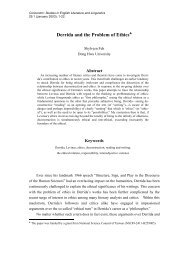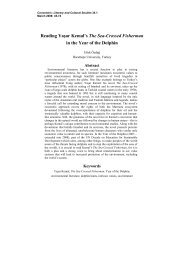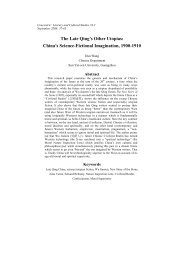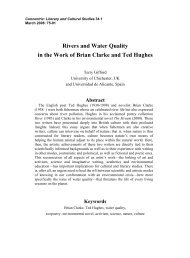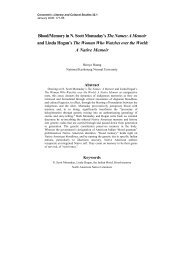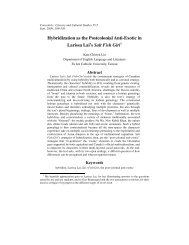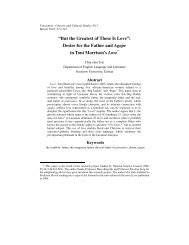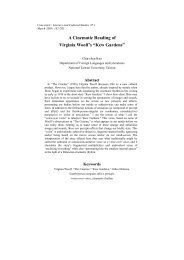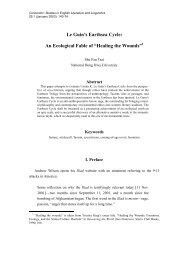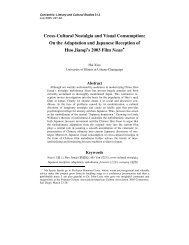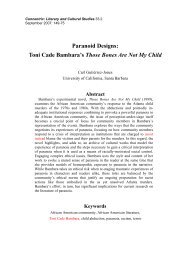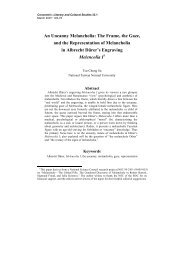The Transforming Aesthetic of the Crime Scene ... - Concentric
The Transforming Aesthetic of the Crime Scene ... - Concentric
The Transforming Aesthetic of the Crime Scene ... - Concentric
Create successful ePaper yourself
Turn your PDF publications into a flip-book with our unique Google optimized e-Paper software.
<strong>Concentric</strong>: Literary and Cultural Studies 38.1March 2012: 79-102<strong>The</strong> <strong>Transforming</strong> <strong>Aes<strong>the</strong>tic</strong> <strong>of</strong> <strong>the</strong><strong>Crime</strong> <strong>Scene</strong> Photograph:Evidence, News, Fashion, and ArtBrittain BrightDepartment <strong>of</strong> English and Comparative LiteratureGoldsmiths, University <strong>of</strong> London, UKAbstract<strong>The</strong> crime scene photograph, which came into being as part <strong>of</strong> an <strong>of</strong>ficialevidence-ga<strong>the</strong>ring process, evolved through <strong>the</strong> tabloid news industry in <strong>the</strong>mid-century United States into a form <strong>of</strong> entertainment. From sensationalnews, <strong>the</strong> imagery, which had become ingrained in <strong>the</strong> public imagination,was co-opted by fashion and art to stage photographs that stylistically evoked<strong>the</strong> crime scene’s visual rhetoric. <strong>The</strong> crime scene aes<strong>the</strong>tic is now part <strong>of</strong> <strong>the</strong>vocabulary <strong>of</strong> many major fashion photographers, and a number <strong>of</strong>contemporary artists use both fashion and crime to question popularperception <strong>of</strong> <strong>the</strong>se images. <strong>The</strong> various adaptations <strong>of</strong> <strong>the</strong> crime scenephotograph have altered <strong>the</strong> aes<strong>the</strong>tic consideration <strong>of</strong> <strong>the</strong> original, so thatarchival examples from police departments and newspapers are being treatedas art in galleries and glossy monographs. <strong>The</strong>se re-imaginings and re-usesraise questions about <strong>the</strong> impact <strong>of</strong> staged imagery on <strong>the</strong> perception <strong>of</strong>au<strong>the</strong>ntic imagery.Keywordsphotography, crime scene, evidence, fashion photography,murder, news, art photography
80 <strong>Concentric</strong> 38.1 March 2012<strong>The</strong> “<strong>Scene</strong> <strong>of</strong> <strong>the</strong> <strong>Crime</strong>” is an evocative term, and designates an evocativeimage. <strong>Crime</strong> scene photographs are presented in courtrooms, films, andnewspapers, layering upon each o<strong>the</strong>r to create a contemporary visual concept <strong>of</strong>crime, one reinforced by every police drama on television. <strong>The</strong>se images have deeproots in <strong>the</strong> history <strong>of</strong> photography, and have developed alongside <strong>the</strong> medium. Thisarticle considers <strong>the</strong> development <strong>of</strong> <strong>the</strong> crime scene photograph from forensicdocument, through journalism and popular entertainment, to its contemporary placeas art object and fashion motif.In his famous satirical essay <strong>of</strong> 1827, “On Murder Considered as One <strong>of</strong> <strong>the</strong>Fine Arts,” Thomas De Quincey describes <strong>the</strong> Society <strong>of</strong> Connoisseurs in Murder:“Every fresh atrocity <strong>of</strong> that class, which <strong>the</strong> police annals <strong>of</strong> Europe bring up, <strong>the</strong>ymeet and criticize as <strong>the</strong>y would a picture, statue, or o<strong>the</strong>r work <strong>of</strong> art.” Has such astate <strong>of</strong> connoisseurship become a reality? Tabloid and police photographs from <strong>the</strong>first half <strong>of</strong> <strong>the</strong> twentieth century currently claim an altered status as art objects, andcrime scene imagery has become a prominent motif in art and fashion photography.Violent death has indeed become a subject <strong>of</strong> aes<strong>the</strong>tic consideration, and notions <strong>of</strong><strong>the</strong> portrayal <strong>of</strong> death are actively explored in contemporary art.Wendy Lesser, author <strong>of</strong> Pictures at an Execution, <strong>of</strong>fers an explanation <strong>of</strong><strong>the</strong> desire to form a narrative shell around <strong>the</strong> event <strong>of</strong> murder: “One <strong>of</strong> <strong>the</strong> reasonswe try to view a real murder as <strong>the</strong>ater—a grand tragedy, a significant event, at <strong>the</strong>very least an authorially constructed plot—is to remove some <strong>of</strong> <strong>the</strong> terrifyingrandomness from it” (190). This contention accounts to some degree for <strong>the</strong>sensational tabloid coverage regularly received by murders, particularly those withphotogenic victims or bizarre complications. Does <strong>the</strong> same urge that leads us to<strong>the</strong>atricalize real murders also account for <strong>the</strong> need to create a stylized, stagedrepresentation <strong>of</strong> <strong>the</strong> act, perhaps as an exercise in exorcism?I.<strong>The</strong> images that introduce this article diverge in many ways, but <strong>the</strong>contemporary viewer will, no doubt, recognize each as a “crime scene photograph.”<strong>The</strong> first is “On <strong>the</strong> Spot,” a photograph <strong>of</strong> <strong>the</strong> great press photographer Weegee atwork at <strong>the</strong> scene <strong>of</strong> <strong>the</strong> murder <strong>of</strong> David “<strong>The</strong> Beetle” Beadle (Figure 1). 1 <strong>The</strong>second is Hugo’s Camera, by Melanie Pullen, a contemporary artist whose series1 Uncredited, 1939.
Brittain Bright 81High Fashion <strong>Crime</strong> <strong>Scene</strong>s 2 addresses historical crime scene images by restaging<strong>the</strong>m in luxurious fashion and saturated color (Figure 2).In <strong>the</strong> journalist’s photograph, <strong>the</strong>re are many hallmarks <strong>of</strong> <strong>the</strong> era, <strong>the</strong> place,and <strong>the</strong> motive <strong>of</strong> <strong>the</strong> photographer. <strong>The</strong> bricks on <strong>the</strong> surface <strong>of</strong> <strong>the</strong> street, <strong>the</strong>formal uniforms <strong>of</strong> <strong>the</strong> police, and <strong>the</strong> interior <strong>of</strong> <strong>the</strong> café in <strong>the</strong> background provideevidence <strong>of</strong> <strong>the</strong> time, 1939. <strong>The</strong> murder <strong>the</strong> photographers are ga<strong>the</strong>ring to covertakes precedence in <strong>the</strong> foreground. <strong>The</strong> police stand by, allowing <strong>the</strong> press butprotecting <strong>the</strong> scene. Street signs denote New York City, <strong>the</strong> corner <strong>of</strong> 10th Avenueand West 46th Street, but it is <strong>the</strong> name <strong>of</strong> <strong>the</strong> café, On <strong>the</strong> Spot, that provides <strong>the</strong>photograph’s title as well as a commentary on <strong>the</strong> press photographer at work.Color is not <strong>the</strong> only aspect <strong>of</strong> Hugo’s Camera that proclaims it a differenttype <strong>of</strong> work. Again, <strong>the</strong> photographer at work is <strong>the</strong> titular subject <strong>of</strong> <strong>the</strong> image,but <strong>the</strong> corpse draws <strong>the</strong> eye, which only returns to <strong>the</strong> incongruous details <strong>of</strong> <strong>the</strong>o<strong>the</strong>r figure after it has taken in <strong>the</strong> deadly details. Though <strong>the</strong> scene iscontemporary, <strong>the</strong> large-format view camera <strong>the</strong> photographer is using to document<strong>the</strong> subject is a tool <strong>of</strong> a much earlier age. His dress also alludes to mid-centurynewsmen, but that <strong>of</strong> his murdered subject is obviously modern. <strong>The</strong> location isanonymous, industrial, and unpopulated—vacant save for <strong>the</strong> photographer and hissubject.<strong>The</strong> journalist’s photograph provides a crime scene complete with victim,police on <strong>the</strong> job, and photographers to document every detail. This might be takenas <strong>the</strong> very definition <strong>of</strong> <strong>the</strong> “crime scene.” <strong>The</strong> artist’s photograph, thoughsimilarly legible on <strong>the</strong> surface, becomes a more complicated object uponexamination. This timeless, placeless spectacle leaves only <strong>the</strong> shorthand <strong>of</strong> <strong>the</strong>crime scene, stripping away o<strong>the</strong>r information in a mockery <strong>of</strong> <strong>the</strong> quest forevidence.Between <strong>the</strong> creation <strong>of</strong> <strong>the</strong> first photograph in 1939 and <strong>the</strong> second in 2004,tabloid journalism fed a public hunger for sensation, <strong>the</strong> crime scene becameinextricably entwined with entertainment culture, and fashion and art photographybegan to appropriate <strong>the</strong>se images for o<strong>the</strong>r purposes. <strong>The</strong> crime scenephotograph—an image <strong>of</strong> a victim and/or site <strong>of</strong> a crime, usually murder—may bereal or staged, explicit or implied, mundane or outlandish. <strong>The</strong> transformation <strong>of</strong> <strong>the</strong>crime scene from a place <strong>of</strong> forensic examination and record to a locus <strong>of</strong> creative2 Hugo’s Camera, Melanie Pullen, 2004. . This and all footnotesfollowing that indicate a website refer to sites where photographs referred to in <strong>the</strong> text arepublished.
82 <strong>Concentric</strong> 38.1 March 2012speculation is rooted in <strong>the</strong> popular entertainments <strong>of</strong> <strong>the</strong> twentieth century, butequally in art history and photographic technique.II.Forensic photography appeared soon after <strong>the</strong> invention <strong>of</strong> stablephotographic processes, as a documentary tool to assist police investigations.Alphonse Bertillon, <strong>the</strong> French statistician who promoted <strong>the</strong> standardization <strong>of</strong>identification photography that led to <strong>the</strong> mug shot, 3 was one <strong>of</strong> <strong>the</strong> firstcriminologists to methodically photograph crime scenes. By <strong>the</strong> turn <strong>of</strong> <strong>the</strong>twentieth century, most large police departments in Europe and North America had<strong>the</strong>ir own photographic departments, and a pamphlet <strong>of</strong> guidelines for photographicevidence-ga<strong>the</strong>ring was published by Friedrich Paul, a Berlin court <strong>of</strong>ficial. 4Swiftly, though, <strong>the</strong> documentary function <strong>of</strong> crime scene photography gaveway to entertainment value. <strong>The</strong> development <strong>of</strong> tabloid journalism fed a publichunger for sensation, and that sensation became linked to an entertainment culture.Weegee, one <strong>of</strong> <strong>the</strong> greatest press photographers <strong>of</strong> all time and a significantcontributor to <strong>the</strong> development <strong>of</strong> <strong>the</strong> noir style, observed <strong>of</strong> his subjects:<strong>The</strong>se are <strong>the</strong> men, women, and children on <strong>the</strong> sidewalks <strong>of</strong> NewYork . . . always rushing by . . . as if life depended on <strong>the</strong>ir reaching<strong>the</strong>ir destination . . . but always finding time to stop and look at afire . . . murder . . . a woman about to jump <strong>of</strong>f a ledge . . . also tolook at <strong>the</strong> latest news flashes on <strong>the</strong> electric sign on <strong>the</strong> TimesBuilding in Times Square . . . <strong>the</strong> latest baseball results pasted in <strong>the</strong>windows <strong>of</strong> stores . . . and to listen to music coming out <strong>of</strong>phonograph stores.<strong>The</strong>y always want to know what paper I’m from and if <strong>the</strong> personis dead. <strong>The</strong>y seem to be disappointed if <strong>the</strong>y see a sign <strong>of</strong> life as <strong>the</strong>stretcher with <strong>the</strong> injured is carried before <strong>the</strong>m. (34)His description consciously positions murder and disaster alongside news andamusement; it also conflates witnesses and subjects, acknowledging that it is <strong>the</strong>photographer who differentiates between <strong>the</strong>m.3 Known as bertillonage, this system was adopted by <strong>the</strong> Paris police force in 1883.4 Friedrich Paul, Handbuch der criminalistischen Photographie für Beamte der Gerichte,Staatsanwaltschaften und der Sicherheitsbehörden 1900.
Brittain Bright 83<strong>The</strong> work <strong>of</strong> tabloid news photographers became a staple <strong>of</strong> <strong>the</strong> inter-warvisual vernacular, particularly in <strong>the</strong> United States. Tabloid newspapers were <strong>the</strong>main source <strong>of</strong> public distribution <strong>of</strong> crime scene photography, and it is largelyfrom <strong>the</strong>se sources that <strong>the</strong> idea <strong>of</strong> <strong>the</strong> crime scene as a consumable image arose.<strong>The</strong> New York Daily News was established in 1919, and helped create <strong>the</strong> hungerfor sensational news still prevalent today. <strong>The</strong> idea <strong>of</strong> “human interest stories” tookhold during this period as well: suddenly, anyone could be news. In a way, it was afar more democratic media culture than our celebrity-centric one, but this sort <strong>of</strong>celebrity came at great cost: one became news only by dying. In Luc Sante’s words:“A prosaic life, conducted in such ordinariness that it might as well be a cloak <strong>of</strong>secrecy, is lit up all at once, at its termination. . . . Suddenly that supine figure,beneath notice when erect an hour ago, becomes an object <strong>of</strong> interest, at leastmomentarily” (Evidence 59).<strong>The</strong> appetite for sensational news grew quickly: in <strong>the</strong> New York Daily News,crime coverage rose from six percent <strong>of</strong> its content in 1920 to twenty-three percentin 1930. In <strong>the</strong> 1940s and 50s, many newspapers published truly shocking images ina competition for sales. A dramatic photograph on <strong>the</strong> front page promised dramainside, much as contemporary glossy magazines promise juicy gossip to <strong>the</strong> reader.<strong>The</strong> crime scene photographs, <strong>of</strong>ten striking in <strong>the</strong>mselves, sometimes emphasizedthis quality with a tragic or dryly comic caption: “Death Throws a Strike” showspolice <strong>of</strong>ficers at work in <strong>the</strong> aftermath <strong>of</strong> a murder which happened during anargument about a World Series baseball game. 5<strong>The</strong> pithy caption was only one <strong>of</strong> <strong>the</strong> talents <strong>of</strong> Weegee, <strong>the</strong> best-knownpress photographer <strong>of</strong> his day. 6 Weegee, born Arthur Fellig, is remembered largelyas a crime photographer who was always <strong>the</strong> first at <strong>the</strong> scene <strong>of</strong> <strong>the</strong> crime, and <strong>the</strong>first to turn in his pictures. He had two (sanctioned) police radios, one in his car andone beside his bed. He was known for <strong>the</strong>se radios, his Speed Graphic camera, andhis car, which had a darkroom in <strong>the</strong> trunk so that he could process <strong>the</strong> night’simages in time for <strong>the</strong> morning’s press. Weegee’s work, much <strong>of</strong> which waspublished by PM Magazine, among o<strong>the</strong>rs, provided not only mass entertainmentand human interest, but also an aes<strong>the</strong>tic that defined an era and style <strong>of</strong>photography. His images are a record <strong>of</strong> New York as he saw it: “<strong>The</strong> people in<strong>the</strong>se photographs are real. Some from <strong>the</strong> East Side and Harlem tenements, o<strong>the</strong>rsare from Park Avenue. In most cases, <strong>the</strong>y weren’t even aware that <strong>the</strong>y were beingphotographed and cared less” (11-12).5 .6 .
84 <strong>Concentric</strong> 38.1 March 2012Weegee was a creation <strong>of</strong> <strong>the</strong> post-World War I hunger for <strong>the</strong> new, andhelped create <strong>the</strong> post-World War II media age. Though he photographed <strong>the</strong> livingand <strong>the</strong> dead from all walks <strong>of</strong> life, it is his crime scene work and that <strong>of</strong> hiscontemporaries that defines much <strong>of</strong> <strong>the</strong> present conception <strong>of</strong> <strong>the</strong> crime sceneaes<strong>the</strong>tic. It is essential to note that this photography was journalistic—created withan eye for <strong>the</strong> dramatic and edited (even sometimes altered) for <strong>the</strong> greatest impact.<strong>The</strong> beginning <strong>of</strong> <strong>the</strong> cross-over from documentary to interpretive photography isnoted by Tim B. Wride in “<strong>The</strong> Art <strong>of</strong> <strong>the</strong> Archive”:One <strong>of</strong> <strong>the</strong> problems with thinking about photographs that depict “<strong>the</strong>scene <strong>of</strong> <strong>the</strong> crime” is that it is irresistibly tempting to conflate <strong>the</strong>mwith work whose purpose is something o<strong>the</strong>r than <strong>the</strong> dispassionatedescription <strong>of</strong> a random occurrence. One always has to ask, at whatpoint does <strong>the</strong> image cease being about <strong>the</strong> scene and start beingabout <strong>the</strong> photograph. <strong>The</strong> New York crime scene images by Weegeeare a great example <strong>of</strong> this phenomenon. Weegee’s images and thoseby his countless competitors were <strong>the</strong> staples <strong>of</strong> tabloid illustration.<strong>The</strong>y have become <strong>the</strong> standards by which we know how a crimescene looks. When one confronts forensic images with <strong>the</strong>ir victimsand criminals, evidence and clues, one is inevitably given entry into aworld that few have actually witnessed first-hand. (21-22)<strong>The</strong> entrée into this world was tempting, illicitly thrilling, and part <strong>of</strong> <strong>the</strong>interest was <strong>the</strong> new visual rhetoric established in <strong>the</strong>se images. Weegee allowedhis viewers to join in a dark experience from <strong>the</strong> comfort <strong>of</strong> <strong>the</strong>ir home, <strong>of</strong>fice, orsubway car, and his aes<strong>the</strong>tic definition <strong>of</strong> this experience became <strong>the</strong> accepted one.This definition was cemented through its evolution into film noir.Weegee, who was a skilled self-promoter, was a part <strong>of</strong> Hollywood’sacceptance and transformation <strong>of</strong> crime scene imagery. After his solo show“Murder Is My Business” at <strong>the</strong> New York Photo League in 1941, his work wasincluded in two exhibits at <strong>the</strong> Museum <strong>of</strong> Modern Art in 1943 and 1944. He founda publisher for his own collection <strong>of</strong> work, Naked City, in 1945. <strong>The</strong> success <strong>of</strong>Naked City inspired a movie <strong>of</strong> <strong>the</strong> same name, and Weegee was hired as aconsultant in Hollywood, which signaled <strong>the</strong> end <strong>of</strong> his news photography days.Perhaps this transition also completed <strong>the</strong> translation <strong>of</strong> <strong>the</strong> journalisticphotography style into entertainment. Many famous films <strong>of</strong> <strong>the</strong> period certainlybear <strong>the</strong> stamp <strong>of</strong> Weegee’s visual influence. In a still <strong>of</strong> <strong>the</strong> murder scene in
Brittain Bright 85Double Indemnity, 7 one <strong>of</strong> <strong>the</strong> most iconic Hollywood Noir thrillers, “<strong>The</strong> framingfor <strong>the</strong> body, <strong>the</strong> desolate surroundings, and, most importantly, <strong>the</strong> single lightsource mimicking a news photographer’s flash gun, are all visual elements <strong>the</strong>public recognized through tabloids. By using this established visual language, <strong>the</strong>studios were able to convey <strong>the</strong>me and plot to viewers, and <strong>the</strong> viewer knew what toexpect” (Sante, New York Noir 21). By <strong>the</strong> 1940s, <strong>the</strong>n, <strong>the</strong> crime scene was imbuedwith glamour, mystery, and suspense, and its association with film noir onlystreng<strong>the</strong>ned <strong>the</strong>se perceptions.However, it is also at this point that a significant shift in <strong>the</strong> imagery occurs.In <strong>the</strong> transition from news photograph to film still, while <strong>the</strong> visual vocabularyremains <strong>the</strong> same, <strong>the</strong>re is an essential difference: <strong>the</strong> documentary scenes arefrequently crowded, full <strong>of</strong> <strong>the</strong> observers Weegee described, who <strong>of</strong>ten becomesubjects <strong>the</strong>mselves. Police and observers crowd into <strong>the</strong> press photos, jostling forpriority in <strong>the</strong> image, or to get a better view. Yet <strong>the</strong> staged images are <strong>of</strong>ten verylonely, focusing on a corpse alone, only occasionally including o<strong>the</strong>rs with aquestionable relationship to <strong>the</strong> dead.This alteration begs <strong>the</strong> question: How does this shift alter <strong>the</strong> position <strong>of</strong> <strong>the</strong>viewer? Are we more complicit in <strong>the</strong> crime itself, now that we cannot join <strong>the</strong>ranks <strong>of</strong> innocent bystanders? Do we become criminals or investigators?<strong>The</strong> loneliness <strong>of</strong> <strong>the</strong> staged scenes is more reminiscent <strong>of</strong> evidencephotographs taken for <strong>the</strong> purpose <strong>of</strong> police investigations. Ra<strong>the</strong>r than engaging<strong>the</strong> viewer as a participant in <strong>the</strong> shot, <strong>the</strong> staged photograph encourages adispassionate appraisal. This shift does not decrease <strong>the</strong> narrative impact or dispel<strong>the</strong> curiosity aroused by <strong>the</strong> image—on <strong>the</strong> contrary, it may increase it by allowingfor a filmic dramatization <strong>of</strong> <strong>the</strong> subject.Film noir imagery brought <strong>the</strong> crime scene fur<strong>the</strong>r into <strong>the</strong> orbit <strong>of</strong> fiction.Film and film stills, <strong>the</strong>n and now, use <strong>the</strong> crime scene’s visual vocabulary torepresent a type <strong>of</strong> event. <strong>The</strong> aes<strong>the</strong>tic <strong>of</strong> <strong>the</strong> crime scene, meaning <strong>the</strong> system <strong>of</strong>symbols 8 that represent <strong>the</strong> documentation <strong>of</strong> <strong>the</strong> results <strong>of</strong> presumably violentcriminal activity, has been established. Though this aes<strong>the</strong>tic began as a reference toactual events, <strong>the</strong> transference <strong>of</strong> <strong>the</strong> subject into <strong>the</strong> fictional realm creates an evengreater need for <strong>the</strong> awareness <strong>of</strong> this vocabulary as a symbolic system. Conscious<strong>of</strong> <strong>the</strong> scene’s fictionality, <strong>the</strong> viewer is at a double remove from <strong>the</strong> subject; notonly is <strong>the</strong> photograph a representation <strong>of</strong> an event, but <strong>the</strong> event itself is arepresentation.7 .8 After Nelson Goodman’s definition <strong>of</strong> “aes<strong>the</strong>tic.”
86 <strong>Concentric</strong> 38.1 March 2012III.<strong>The</strong> fictionalization <strong>of</strong> death has become an important motif in artphotography, but, as Elizabeth Bronfen contends in Over Her Dead Body, this is nota contemporary phenomenon. Bronfen situates <strong>the</strong> imagery <strong>of</strong> <strong>the</strong> beautiful deadwoman in eighteenth- and nineteenth-century Western art history, literature, andculture. Well-known images such as Millais’s Ophelia and various literaryexamples including Dracula, <strong>The</strong> Woman in White, and Wu<strong>the</strong>ring Heights support<strong>the</strong> contention that this imagery was, and is, part <strong>of</strong> a prevalent cultural pattern.<strong>The</strong> influence <strong>of</strong> this tradition is evident in <strong>the</strong> alteration <strong>of</strong> <strong>the</strong> subject whenjournalistic photographs give way to artistic ones: <strong>the</strong> dead man has now <strong>of</strong>tenbecome a dead woman. <strong>The</strong> combination <strong>of</strong> <strong>the</strong> “beautiful dead woman” image and<strong>the</strong> crime scene aes<strong>the</strong>tic has created a typology <strong>of</strong> its own. As Bronfen says, “Thisimage <strong>of</strong> a feminine corpse presents a concept <strong>of</strong> beauty which places <strong>the</strong> work <strong>of</strong>death into <strong>the</strong> service <strong>of</strong> <strong>the</strong> aes<strong>the</strong>tic process, for this form <strong>of</strong> beauty is contingenton <strong>the</strong> translation <strong>of</strong> an animate body into a deanimated one” (5). She is referencinga popular nineteenth-century painting (Gabriel von Max, Der Anatom, 1869), 9 bu<strong>the</strong>r statement could apply to photography as a medium—that which stops, freezes,preserves <strong>the</strong> image <strong>of</strong> an animated being and, in a staged crime scene,characterizes that being as de-animated.Perhaps it is <strong>the</strong> tradition <strong>of</strong> idealizing <strong>the</strong> beautiful dead woman thatultimately allied <strong>the</strong> crime scene with fashion. Edgar Allen Poe said, in an essayabout <strong>the</strong> composition <strong>of</strong> “<strong>The</strong> Raven,” “<strong>the</strong> death . . . <strong>of</strong> a beautiful woman isunquestionably <strong>the</strong> most poetical topic in <strong>the</strong> world.” As a source <strong>of</strong> motivation for<strong>the</strong> artist, this seems to hold true in <strong>the</strong> twentieth and twenty-first centuries. As <strong>the</strong>central subject <strong>of</strong> fashion photography is <strong>the</strong> beautiful woman, it seems inevitablethat death, this most poetic <strong>of</strong> topics, should also be a part <strong>of</strong> <strong>the</strong> fashionphotographer’s vocabulary.By <strong>the</strong> time A. D. Coleman published his seminal 1976 article in ArtForumproposing a new “directorial mode” for art photography (56), fashion photographerGuy Bourdin, along with o<strong>the</strong>rs such as Richard Avedon, Helmut Newton, andIrving Penn, had been practicing in that mode for decades. Fashion photography,because it had no documentary duty, had even more interpretive leeway than tabloidnews photography. Though some felt, as did <strong>The</strong> New York Times in 1975, that <strong>the</strong>images Bourdin and Newton published in Paris Vogue were “indistinguishable from9 .
Brittain Bright 87an interest in murder, pornography and terror” (qtd. in Rushton), o<strong>the</strong>rs found <strong>the</strong>mrevolutionary.Newton’s preoccupation with sexual fetishes and Bourdin’s fascination withdeath and ambiguity were intended to be disruptive—<strong>the</strong> way <strong>the</strong>se photographersenvisioned <strong>the</strong>ir role as authors <strong>of</strong> <strong>the</strong> image changed <strong>the</strong> way that fashionphotographers practice. <strong>The</strong> disturbing power <strong>of</strong> Bourdin’s work is particularlyimportant to <strong>the</strong> discussion <strong>of</strong> <strong>the</strong> crime scene’s progress from document to artobject. His photographs introduced into fashion a stylized, extravagant vision <strong>of</strong>death that has been influential ever since. 10Bourdin was one <strong>of</strong> <strong>the</strong> great fashion photographers <strong>of</strong> <strong>the</strong>1960s and 70s, andleft behind an unparalleled body <strong>of</strong> work, only published in his lifetime in fashionmagazines. Early in his career, Bourdin contacted Man Ray and expressed a desireto align himself and his work with <strong>the</strong> Surrealist movement. A strong sense <strong>of</strong>surrealism is certainly evident from his earliest photographs, but <strong>the</strong> narrativepower <strong>of</strong> <strong>the</strong> images grew throughout his career. “Bourdin understood,” says AlisonM. Gingeras, “that <strong>the</strong> cultivation <strong>of</strong> desire in fashion photography did not comefrom <strong>the</strong> simple description <strong>of</strong> <strong>the</strong> featured product.” He created drama around thatproduct, and made <strong>the</strong> photograph itself an arresting object, <strong>the</strong> hat, shoe, or braonly a part <strong>of</strong> it.Bourdin’s <strong>of</strong>ten-surreal images are vibrant, saturated with color, andnarratively ambiguous. Many echo a crime scene, in more or less explicit terms.One famous image features a chalk outline, o<strong>the</strong>rs prone bodies, but somethingabout <strong>the</strong> photographs, perhaps simply <strong>the</strong>ir exaggeration and powerful color,makes <strong>the</strong>m seem more alive than dead. His references are sometimes merelyteasing suggestions. An image for French Vogue, for example, which features awoman draped across a chair and a man’s hand extending as though to switch out alight, suggests death, but equally sexual abandon or satisfaction. <strong>The</strong> man might bea murderer, a lover, a voyeur. And <strong>the</strong> tantalizingly half-closed door indicates,perhaps, that <strong>the</strong> viewer is both meant to see and not to see, to always remainunsatisfied. Francine Crescent, editor <strong>of</strong> French Vogue from 1968 to 1987 andBourdin’s first champion, said: “He knew before anyone that sex and violence weregoing to be very important factors in our society. But I think that he was interestedin, and wanted to describe, life itself” (qtd. in Gingeras).Bourdin described death, like sex, as a necessary part <strong>of</strong> life’s drama, aseductive and intriguing part. In doing so, he became a hugely influential figure in<strong>the</strong> fashion world: many contemporary fashion photographers cite him as an10 .
88 <strong>Concentric</strong> 38.1 March 2012influence, and his narrative vision certainly contributed to <strong>the</strong> idea that fashionspreads have become “stories.” In his unique photographs, he was pursuing morethan <strong>the</strong> perfect image. Indeed, says Serge Lutens, he “conduct[ed] his ownpsychoanalysis in Vogue” (qtd. in Haden-Guest 139). <strong>The</strong> confluence <strong>of</strong> darknessand humor in Bourdin’s photographs may suggest that he was searching for alighter side <strong>of</strong> perversion, violence, and psychodrama.Bourdin’s visual concepts are innovations in that <strong>the</strong> viewer findshimself present at a crucial point in <strong>the</strong> drama—even while having<strong>the</strong> impression that <strong>the</strong> important actor isn’t in <strong>the</strong> image, that it’staking place separately, before or after, that some threat is looming,that some inexplicable event is happening, betokened only by a cluein <strong>the</strong> corner <strong>of</strong> <strong>the</strong> frame. Are we in <strong>the</strong> realm <strong>of</strong> dream or reality? Insome unsettling between-place? <strong>The</strong>re, anything is believable . . . <strong>the</strong>viewer projects his imagination, lets it run wild. Soon, however,panic ensues, because <strong>the</strong> photograph poses more questions than itanswers, suggests more than it shows. Thus Bourdin creates imagesthat are never serene. <strong>The</strong> suffocating atmosphere is reinforced by <strong>the</strong>fact that <strong>the</strong> scenes <strong>of</strong>ten take place in closed, confined spaces—atelephone booth, a windowless room, a corner <strong>of</strong> a room or a wall.<strong>The</strong> use <strong>of</strong> a 15mm Nikon lens, on <strong>the</strong> market in <strong>the</strong> 1970s, allowshim to obtain a clean, undistorted frame, in which no “piece <strong>of</strong>evidence” is given priority. (Guerrin; emphasis in original)Michel Guerrin’s reference to “evidence” above is telling. It is impossible toview Bourdin’s most powerful narrative images without some consciousness <strong>of</strong><strong>the</strong>ir crime scene antecedents. Gingeras also argues that Bourdin’s engagement with<strong>the</strong> crime scene “might also have been motivated by a highly conceptualunderstanding <strong>of</strong> photography’s history.” She reads <strong>the</strong> self-referentiality andconscious fictionality <strong>of</strong> <strong>the</strong> images as a commentary on <strong>the</strong> evidentiary quality <strong>of</strong>photography itself.Since his death, Bourdin’s work has been more accessible, and has gained anew generation <strong>of</strong> admirers. Despite his estate’s desire to “disassociate” Bourdin’swork from its crime scene antecedents, as evidenced by <strong>the</strong>ir refusal to allow <strong>the</strong>publication <strong>of</strong> his images in this article, his photographs continue to speak for<strong>the</strong>mselves.
Brittain Bright 89One image resonates particularly with police photographs <strong>of</strong> a notorious andunsolved crime, <strong>the</strong> Black Dahlia murder. <strong>The</strong>se crime scene photographs, 11 takenin Los Angeles in 1947, may be read as a <strong>the</strong>oretical precursor to a 1978 CharlesJourdan shoe advertisement by Guy Bourdin. 12<strong>The</strong> Black Dahlia, as <strong>the</strong> press dubbed Elizabeth Short after her death, was <strong>the</strong>victim <strong>of</strong> a particularly gruesome, and thus particularly newsworthy, murder. Hernaked body was found in a vacant lot, bisected and drained <strong>of</strong> blood; she had beenrestrained, tortured, and mutilated, probably over a matter <strong>of</strong> days. <strong>The</strong> caseremains unsolved, though many people confessed and were accused, and it hasrecently been <strong>the</strong>orized that <strong>the</strong> murder was a perverse act <strong>of</strong> Surrealism on <strong>the</strong> part<strong>of</strong> Dr. George Hodel. 13 Though it was widely reported and sensationalized, images<strong>of</strong> <strong>the</strong> murder were considered too shocking even for <strong>the</strong> press <strong>of</strong> <strong>the</strong> time, whichfrequently featured violent crime scenes. <strong>The</strong> only photographs <strong>of</strong> <strong>the</strong> scene arethose taken by <strong>the</strong> Los Angeles Police Department. James Ellroy, who wrote anovel based on <strong>the</strong> case, writes: “She may have been a party girl, a movie extra, or apart-time prostitute. <strong>The</strong> savagery <strong>of</strong> her murder distances and seduces and leavesone at a loss to ascribe context or motive” (13).<strong>The</strong> connection to Surrealism may be evidentially tenuous, but it ispsychologically and visually compelling. Considering <strong>the</strong> fractured images <strong>of</strong> <strong>the</strong>body photographed and filmed by Man Ray, Marcel Duchamp, and Georges Hugnet,<strong>the</strong> intentional positioning <strong>of</strong> <strong>the</strong> body at <strong>the</strong> Black Dahlia murder scene appears tobe a purposeful directorial act. Film critic David Thomson muses that “<strong>the</strong>intellectual daring <strong>of</strong> such pictures cannot quite be separated from a torturer’scoolness”; <strong>the</strong> <strong>the</strong>ories <strong>of</strong> disruption that proved so seductive in art may also haveinspired murderers.As compelling as <strong>the</strong> Surrealist associations <strong>of</strong> this murder may be, what isundeniable is <strong>the</strong> relationship, intentional or accidental, <strong>of</strong> <strong>the</strong> evidence photographswith <strong>the</strong> Bourdin image. <strong>The</strong> bisection <strong>of</strong> <strong>the</strong> body by <strong>the</strong> camera is not a literaldismemberment, but it removes <strong>the</strong> model’s identity, so that she becomes only bodyparts. <strong>The</strong> pristine, saturated orange <strong>of</strong> <strong>the</strong> s<strong>of</strong>a and <strong>the</strong> accessories at once evokes<strong>the</strong> brightness <strong>of</strong> blood and deprecates its vulgarity. <strong>The</strong> hard flash recalls <strong>the</strong>tabloid or police photographer; it illuminates every corner <strong>of</strong> a dark place. <strong>The</strong>woman’s legs are spread, though arguably in a way that is less wanton than coy. Is11 .(Warning: graphic documentary crime scene images)12 .13 See Hodel; Nelson and Bayliss.
90 <strong>Concentric</strong> 38.1 March 2012this woman alive? <strong>The</strong> awkwardness <strong>of</strong> her pose seems to call her agency intoquestion, if not her physical animation. What is she doing in such a strange position?<strong>The</strong> viewer is compelled to imagine <strong>the</strong> larger scene; though <strong>the</strong> conscious mindknows <strong>the</strong> photograph is designed to advertise shoes, <strong>the</strong> unconscious wants todelve fur<strong>the</strong>r into <strong>the</strong> story.A story is <strong>the</strong> allure <strong>of</strong> all crime scene images, both staged and forensic. <strong>The</strong>newspapers created a dramatic narrative and a romantic nickname for ElizabethShort because <strong>of</strong> <strong>the</strong> horrifyingly <strong>the</strong>atrical manner <strong>of</strong> her death. A viewer iscompelled to wonder about <strong>the</strong> awkward elegance <strong>of</strong> a Bourdin photograph.Perceived drama draws <strong>the</strong> viewer into <strong>the</strong> image—<strong>the</strong> apparent <strong>the</strong>atricality even<strong>of</strong> a documentary photograph implies a surrounding narrative, and engages curiosity.While evidence and advertising are distinct image types, <strong>the</strong> visual rhetoric linking<strong>the</strong>m has a historical and <strong>the</strong>matic, as well as formal, logic.IV.To compare an evidence photograph and an advertising photograph iscertainly a gross exaggeration <strong>of</strong> <strong>the</strong> glamour <strong>of</strong> one and <strong>the</strong> violence <strong>of</strong> <strong>the</strong> o<strong>the</strong>r.However, <strong>the</strong> implications <strong>of</strong> both violence and glamour have become intrinsic inall crime scenes and create a complicated visual relationship between fiction andforensics.It is perhaps in fashion that <strong>the</strong> crime scene <strong>the</strong>me has been most influential,and most inflammatory. Guy Bourdin’s visual influence, and more generally <strong>the</strong>confluence <strong>of</strong> fashion and crime, is evident in <strong>the</strong> work <strong>of</strong> many <strong>of</strong> today’s mostimportant fashion and art photographers: David LaChapelle, Inez van Lamsweerdeand Vinoodh Matadin, Steven Klein and Tim Walker owe to Bourdin something <strong>of</strong><strong>the</strong>ir saturated and exaggerated styles. O<strong>the</strong>r photographers who frequently employcrime scene references, including Steven Meisel, Mert Alas and Marcus Piggott,and Miles Aldridge, are currently among <strong>the</strong> most published in major fashionmagazines.Photographs that clearly reference <strong>the</strong> crime scene aes<strong>the</strong>tic have recentlyappeared in Vogue Italia (Meisel, “Water and Oil,” August 2010), 14 Vogue KoreaGirl (Oh Joong Seok, “Oh My Ophelia,” April 2007), 15 W magazine (Mert andMarcus, “Into <strong>the</strong> Wood,” August 2007) 16 and in ad campaigns by Louis Vuitton14 .15 .16 .
Brittain Bright 91(Meisel, S/S 2010), 17 Marc Jacobs (Juergen Teller, A/W 2010), 18 Versace (MarioTestino, S/S 2010), 19 and Superette (Charles Howells, A/W 2009). 20 Celebrityportraits in fashion magazines also regularly adopt this vernacular, includingRooney Mara (Mert and Marcus, American Vogue, October 2011), 21 Madonna(Meisel, W, June 2006), 22 and Charlize <strong>The</strong>ron (Mario Sorrenti, W, February2012). 23All <strong>of</strong> this work demonstrates mainstream acceptance <strong>of</strong> crime scene imagery;though frequently it is denounced as deplorable, it is still in fashion. <strong>The</strong> idea <strong>of</strong> <strong>the</strong>crime scene as a subject <strong>of</strong> fashion photography has become increasingly legible, asis evidenced by its use in 2007 on <strong>the</strong> popular television program America’s NextTop Model. 24 One episode’s photo shoot staged <strong>the</strong> contestants’ death scenes asthough <strong>the</strong>y had been “killed by ano<strong>the</strong>r model” in various ways. However, <strong>the</strong>inclusion <strong>of</strong> this crime scene <strong>the</strong>me shocked many viewers, provoked a protest from<strong>the</strong> National Organization for Women, and was reviewed negatively by many pressoutlets, including <strong>the</strong> liberal Huffington Post (Lafsky). <strong>The</strong> intensity <strong>of</strong> <strong>the</strong> responseto this program is interesting, given not only <strong>the</strong> precedent in fashion photographyfor such images, but also <strong>the</strong> television context—presumably viewers <strong>of</strong> Top Modeloverlap with viewers <strong>of</strong> graphic police procedural shows, in which images <strong>of</strong> crimescenes are common. Why, <strong>the</strong>n, did <strong>the</strong>ir displacement into a fashion contextprovoke condemnation?Jacque Lynn Foltyn asserts that “corpse chic” is a phenomenon that embracesboth genres. She associates <strong>the</strong> performance <strong>of</strong> death in <strong>the</strong>se images with dramaticrepresentation, pointing to “an era <strong>of</strong> media convergence” in which televisionshows inspire fashion editorials. Certainly, <strong>the</strong> perceptual intersection <strong>of</strong> fact andfiction seems to be increasing. <strong>The</strong> imagery <strong>of</strong> <strong>the</strong> crime scene photograph has beenperpetuated by television shows, beginning with reality-based docudramas such as17 .18 .19 .20 .21 .22 .23 .24 America’s Next Top Model, Cycle 8, Episode 4. .
92 <strong>Concentric</strong> 38.1 March 2012America’s Most Wanted. <strong>The</strong> interest in <strong>the</strong> investigative process itself has led tomore process-based television dramas like Law and Order, but it has culminated,from <strong>the</strong> point <strong>of</strong> view <strong>of</strong> forensics and evidence photography, in CSI (<strong>Crime</strong> <strong>Scene</strong>Investigation), which has spawned many imitators and is <strong>the</strong> most-watchedtelevision drama in <strong>the</strong> world. <strong>The</strong> series is premised upon its “veneration <strong>of</strong>evidence” (Kompare 14), and its structure is such that <strong>the</strong> crime scene continues toexert not only fascination but also narrative primacy. However, it is only ano<strong>the</strong>rstep <strong>of</strong> <strong>the</strong> crime scene’s passage into our modern visual vernacular—“memories”<strong>of</strong> crime scenes in movies, TV shows, or books seem more real now than crimescene photos released by police departments.It seems clear that contemporary society embraces a double standardregarding dramatized versus glamorized crime scenes. Though fashion photographsmay have an implicit narrative, <strong>the</strong> photograph may still be said, in Susan Sontag’swords, to “turn . . . people into objects that can be symbolically possessed” (14);certainly fashion is <strong>of</strong>ten accused <strong>of</strong> “objectification.” It is at this point that <strong>the</strong>question <strong>of</strong> narrative, and <strong>the</strong> definition <strong>the</strong>re<strong>of</strong>, becomes paramount. <strong>The</strong> televisiondrama is to some degree exempt from allegations <strong>of</strong> exploitation because crimescene images are needed to spur <strong>the</strong> central focus <strong>of</strong> <strong>the</strong> story, which is <strong>the</strong>investigation that takes place afterwards. In staged photographic crime scenes, anynarrative must expand from <strong>the</strong> still image or set <strong>of</strong> images; although <strong>the</strong>implication <strong>of</strong> narrative is central to <strong>the</strong> creation and staging <strong>of</strong> such images, it is<strong>of</strong>ten intuitive, illogical, and fantastic.<strong>The</strong> lack <strong>of</strong> a framework <strong>of</strong> justification for fashion stories leaves <strong>the</strong>m opento attack. Like Surrealism, fashion refers to its own interior logic, which CarolineEvans, in Fashion at <strong>the</strong> Edge, terms “cultural poetics” (10). She argues that darkimagery is a natural part <strong>of</strong> <strong>the</strong> fashion industry:<strong>The</strong> fascination <strong>of</strong> <strong>the</strong> dark side <strong>of</strong> life is <strong>the</strong> o<strong>the</strong>r side <strong>of</strong> <strong>the</strong> coin <strong>of</strong>fashion’s emphasis on idealized bodies. <strong>The</strong>se norms and stereotypesare only half <strong>the</strong> picture, so we are drawn to <strong>the</strong> negated or neglectedo<strong>the</strong>r side, be it cultural o<strong>the</strong>rness or death. In <strong>the</strong>se images fashionfunctions as a symptom to evoke its opposite, so that glamour masksdecay, but <strong>the</strong> latter returns as <strong>the</strong> repressed <strong>of</strong> <strong>the</strong> former. (227)Death in fashion imagery acknowledges <strong>the</strong> undercurrent <strong>of</strong> ephemerality andalteration that underpin <strong>the</strong> constant production <strong>of</strong> new styles and new ways <strong>of</strong>presenting <strong>the</strong>m.
Brittain Bright 93V.Contemporary art photographers working with this artistic heritage have mademore direct references to crime scene photography, and made efforts to deconstructits aes<strong>the</strong>tic appeal. Melanie Pullen, <strong>the</strong> American artist whose staged photographintroduces this article, became famous with her High Fashion <strong>Crime</strong> <strong>Scene</strong>s, shotbetween 1995 and 2005. She references Luc Sante’s Evidence as her inspiration,saying,It made me think about what had anae<strong>the</strong>tised me to <strong>the</strong> photographsand I decided to make a series that purposely distracts one from <strong>the</strong>crime in every way possible. Vivid colours, beautiful models, fashion.Anything. My intention is that you walk away from my show with <strong>the</strong>reaction I had when I was looking at that book. You only realiseafterwards what you were looking at and you reflect for a secondabout it and yourself. (qtd. in Crissell 11)Pullen’s photographs, some based on images from Evidence, o<strong>the</strong>rs on herresearch in <strong>the</strong> Los Angeles police archives, include an image <strong>of</strong> beautifully-shodfeet poking out <strong>of</strong> a barrel that is distinctly reminiscent <strong>of</strong> Bourdin. Her work,however, frequently pushes fur<strong>the</strong>r into <strong>the</strong> graphic and definite. In images such asPhones (Figure 3), Pullen’s aim is realized: <strong>the</strong> detail <strong>of</strong> <strong>the</strong> environment and <strong>the</strong>lushness <strong>of</strong> <strong>the</strong> overall image make it difficult to concentrate on <strong>the</strong> model, andeven more difficult to process her condition as dying or dead.Pullen’s work examines <strong>the</strong> crime scene through fashion, and vice versa. <strong>The</strong>initial impression <strong>of</strong> many individual images may be similar to that <strong>of</strong> a fashionphotograph, but <strong>the</strong>re are subtle differences that become apparent when one views<strong>the</strong> work as a whole. <strong>The</strong> photographs acknowledge <strong>the</strong>ir roots in evidence byplacing as much emphasis on <strong>the</strong> surroundings as on <strong>the</strong> model. <strong>The</strong> repetition <strong>of</strong>“death” also sets this work apart from a fashion story. In a magazine, onlyoccasionally is a story entirely composed <strong>of</strong> “dead” images—usually <strong>the</strong>se are<strong>of</strong>fset by o<strong>the</strong>rs <strong>of</strong> <strong>the</strong> same model in o<strong>the</strong>r poses, so that <strong>the</strong> fictionality <strong>of</strong> herdeath is reinforced. In “High Fashion <strong>Crime</strong> <strong>Scene</strong>s,” however, <strong>the</strong> models are notresurrected or repeated. <strong>The</strong>y are simply dead, like <strong>the</strong> victims in <strong>the</strong> evidencephotographs.Guerrin’s statement that “no piece <strong>of</strong> evidence is given priority” is equallytrue <strong>of</strong> Pullen’s photographs. <strong>The</strong> viewer is faced with a discrepancy between two
94 <strong>Concentric</strong> 38.1 March 2012visual urges, to take in detail and to accept <strong>the</strong> presentation <strong>of</strong> a narrative. Pullen’sphotographs use <strong>the</strong> idea <strong>of</strong> evidence as a tool—by presenting too much, any valueis nearly lost.In restaging <strong>the</strong>se scenes, Pullen is questioning, among o<strong>the</strong>r things, <strong>the</strong>ability <strong>of</strong> <strong>the</strong> photographic medium to represent reality in <strong>the</strong> way it intends. WendyLesser comments: “As readers or viewers <strong>of</strong> a fictional work, we are meant to betaken in, to be deluded into believing, and we are also meant to understand thatwhat we are believing in is not real, is not life on <strong>the</strong> same order or under <strong>the</strong> samerules as we live it” (14). Staged photography allows <strong>the</strong> viewer to become absorbedin an image, but at <strong>the</strong> same time to be conscious <strong>of</strong> <strong>the</strong> fraught relationshipbetween <strong>the</strong> performance in that image and <strong>the</strong> source text (<strong>the</strong> original crime scenephotograph).Ano<strong>the</strong>r artist who works with ideas about fashion, <strong>the</strong> crime scene, and <strong>the</strong>presentation <strong>of</strong> evidence is Japanese photographer Izima Kaoru. In <strong>the</strong> series“Landscapes with a Corpse” (Figure 4), he creates death portraits <strong>of</strong> celebrities,mostly Japanese, who choose <strong>the</strong> wardrobe in which <strong>the</strong>y would like to stage <strong>the</strong>irown death. His images operate in groups, beginning with <strong>the</strong> titular landscape, and<strong>of</strong>ten coming to rest in <strong>the</strong> end on <strong>the</strong> face. This sequencing technique reads in afilmic way, like a Hitchcockian zoom, moving from <strong>the</strong> overview to <strong>the</strong> personal. Inthis way, Izima plays on <strong>the</strong> idea <strong>of</strong> crime scene documentation and its attempt tocreate a complete description <strong>of</strong> <strong>the</strong> scene through multiple images.In his view, he is working from <strong>the</strong> perspective <strong>of</strong> a spirit, and <strong>the</strong> multipleangles and distances are different ways <strong>of</strong> regarding death. Izima says that fashionphotography liberates its artist as well as its subject: “Fashion photography is asimulation play on everyday lives or lifestyles, to fulfill <strong>the</strong> readers’ desires for <strong>the</strong>ideal lives or styles that <strong>the</strong>y want but cannot be courageous enough to lead. I think,<strong>the</strong>n, <strong>the</strong> moment <strong>of</strong> death can be simulated as a <strong>the</strong>me <strong>of</strong> fashion photography, aswell.” His acceptance <strong>of</strong> death as a fact <strong>of</strong> <strong>the</strong> ideal life is a counterpoint to <strong>the</strong> idea<strong>of</strong> a “pornography” <strong>of</strong> death that results from <strong>the</strong> denial <strong>of</strong> its part in life (Gorer 21).Perhaps death does not have to be taboo to be glamorized, and perhaps it is not <strong>the</strong>glamorization but <strong>the</strong> death itself that is seen as objectionable.Conversely, it is possible that <strong>the</strong> appeal <strong>of</strong> <strong>the</strong> crime scene <strong>the</strong>me is perhapsnot death, but ra<strong>the</strong>r mystery. Narratively, <strong>the</strong>se images contain mystery in that <strong>the</strong>yconnote <strong>the</strong> unsolved crime; <strong>the</strong> incomplete “evidence” <strong>of</strong> real or staged images isan invitation to participate in <strong>the</strong>orizing, or in completing <strong>the</strong> narrative. In a largersense, such images evoke <strong>the</strong> impossibility <strong>of</strong> knowing <strong>the</strong> whole “truth,” ei<strong>the</strong>r <strong>of</strong>photography or <strong>of</strong> death.
Brittain Bright 95<strong>The</strong> photographer who stages an image alters <strong>the</strong> medium, transformativelyrecording a pause or a suspended moment ra<strong>the</strong>r than capturing an event. No longeris <strong>the</strong> photographer an observer and recorder, but a creator. If <strong>the</strong> scene created is acrime scene, is <strong>the</strong> photographer <strong>the</strong> fictional murderer or <strong>the</strong> fictional witness? In<strong>The</strong> <strong>Aes<strong>the</strong>tic</strong>s <strong>of</strong> Murder, Joel Black muses on <strong>the</strong> relationship between <strong>the</strong>se tworoles:<strong>The</strong> intimacy between <strong>the</strong> murderer and <strong>the</strong> witness—<strong>the</strong> mutualexperience <strong>of</strong> sublime suspension from worldly concerns that <strong>the</strong>yshare in <strong>the</strong> presence <strong>of</strong> <strong>the</strong> victim’s corpse, <strong>the</strong>ir secret knowledgethat <strong>the</strong>y (and <strong>the</strong> reader) savor for a few interminable instants before<strong>the</strong> alarm is raised and <strong>the</strong> event is made public—has a distinctlyerotic character. <strong>The</strong> commonplace reference to sexual climax as apetite mort takes on a deeper significance with respect to murder (106;emphasis in original).<strong>The</strong> staged photograph encapsulates this moment <strong>of</strong> witness, allowing <strong>the</strong>photographer to share with <strong>the</strong> viewer that experience <strong>of</strong> <strong>the</strong> sublime. Ironically,this moment <strong>of</strong> transcendence may be <strong>the</strong> reason for <strong>the</strong> linkage <strong>of</strong> crime sceneswith fashion. <strong>The</strong> extremity and <strong>the</strong> narrative strength <strong>of</strong> <strong>the</strong> crime scene empowerfashion, even as one distracts from <strong>the</strong> o<strong>the</strong>r.<strong>The</strong> idea that death, particularly violent death, can be co-opted by art mayseem incomprehensible to some, but <strong>the</strong> idea <strong>of</strong> <strong>the</strong> crime scene is so much a part <strong>of</strong>contemporary visual culture as to make this process inevitable. <strong>The</strong> permissiveculture <strong>of</strong> <strong>the</strong> fashion photography has opened <strong>the</strong> door for <strong>the</strong>se artists to use <strong>the</strong>aes<strong>the</strong>tic <strong>of</strong> <strong>the</strong> crime scene to comment on <strong>the</strong> relationship between art and fashion,as well as on popular imagination and <strong>the</strong> idea <strong>of</strong> <strong>the</strong> surreal.Izima and Pullen, as well as o<strong>the</strong>r photographers working within <strong>the</strong> structure<strong>of</strong> <strong>the</strong> fashion industry, have created a new sense <strong>of</strong> <strong>the</strong> crime scene as anappropriate topic <strong>of</strong> art as well as a point <strong>of</strong> intersection between art and fashion.<strong>The</strong>y are not <strong>the</strong> first, however, to find <strong>the</strong> crime scene a fruitful topic. It is arecurring <strong>the</strong>me in <strong>the</strong> work <strong>of</strong> British artist John Hilliard, whose photographs dealwith perception, points <strong>of</strong> view, and <strong>the</strong> fraught nature <strong>of</strong> <strong>the</strong> photograph asevidentiary object. His photograph Miss Tracy (Figure 5) seems at first a wrycommentary on <strong>the</strong> elimination <strong>of</strong> information practiced by contemporary newsoutlets. In recent years, <strong>the</strong> news media have provided increasingly less information.<strong>The</strong> photograph published by several British newspapers as documentation <strong>of</strong> <strong>the</strong>
96 <strong>Concentric</strong> 38.1 March 2012scene <strong>of</strong> <strong>the</strong> murder <strong>of</strong> student Meredith Kercher in 2007 is a degraded photocopy,in which little <strong>of</strong> sensational or evidentiary value is visible. Never<strong>the</strong>less, <strong>the</strong> onesmall area in which a human form might be visible has been blurred out. <strong>The</strong>opacity <strong>of</strong> what might be <strong>the</strong> crucial part <strong>of</strong> Hilliard’s scene recalls <strong>the</strong> illegibility <strong>of</strong>journalistic images, which stand in drastic contrast to those <strong>of</strong> <strong>the</strong> tabloid’s heyday.Miss Tracy also addresses <strong>the</strong> disturbing possibility <strong>of</strong> <strong>the</strong> crime scene aserotic object: <strong>the</strong> center <strong>of</strong> <strong>the</strong> picture is out <strong>of</strong> focus, “leaving us with no more thana general impression <strong>of</strong> a s<strong>of</strong>tly erotic figure, a reading encouraged by <strong>the</strong> lack <strong>of</strong>focus and by <strong>the</strong> red ground.” This impression is contradicted by <strong>the</strong> sharplyfocused border <strong>of</strong> <strong>the</strong> image, which reveals bruised limbs and pieces <strong>of</strong> clothing.Hilliard continues: “<strong>The</strong> red ground turns out to be a white sheet so bloodied as tobe like a butcher’s cloth, and a presumption <strong>of</strong> violence overrides and condemnsthat initial erotic resonance.”<strong>The</strong> body at <strong>the</strong> heart <strong>of</strong> <strong>the</strong> crime scene image is <strong>the</strong> impetus behind much <strong>of</strong><strong>the</strong> conflict surrounding such images, but it is also <strong>the</strong> reason for <strong>the</strong>ir power.American photographer Sally Mann 25 encountered resistance from her gallery whenshe created her series What Remains, which includes photographs made at <strong>the</strong>University <strong>of</strong> Tennessee Forensic Anthropology Facility, “a study site wherescientists, students, doctors, and law enforcement <strong>of</strong>ficers research <strong>the</strong>decomposition <strong>of</strong> human remains.” 26 Eventually shown at <strong>the</strong> Corcoran Gallery,this (untitled) section <strong>of</strong> What Remains addresses <strong>the</strong> evidentiary aspect <strong>of</strong> <strong>the</strong>photograph as well as <strong>the</strong> forensic process.This work is at once documentary and subjective—<strong>the</strong> bodies <strong>the</strong>mselves arereal, but <strong>the</strong>y are “staged” as subjects <strong>of</strong> study. Mann’s photographs are at oncedocuments <strong>of</strong> and meditations on <strong>the</strong>se composed realities. Underpinned by <strong>the</strong>forensic nature <strong>of</strong> <strong>the</strong> subject, <strong>the</strong>y function as meta-commentary on crime scenesand, in Mann’s words, <strong>the</strong> “cultural iconography <strong>of</strong> death.”VI.Such an iconography is indisputably at work in <strong>the</strong> creation <strong>of</strong> <strong>the</strong> aes<strong>the</strong>tic <strong>of</strong><strong>the</strong> crime scene. <strong>The</strong> legibility <strong>of</strong> <strong>the</strong> images created by artists and fashionphotographers depends on cultural memory and continual reinforcement to establisha set <strong>of</strong> signs by which <strong>the</strong> crime scene may be defined, but also to define what itmeans. Caleb Williams writes: “It is about photography as testimony, photography25 .26 What Remains, Corcoran Gallery, Washington D.C., 12 June-6 September 2004.
Brittain Bright 97working as a rationally-based evidence collecting activity, but also about eachcrime scene photograph as a receptacle for catching and commemorating somethingmore.” This idea <strong>of</strong> something that has happened, <strong>of</strong> which only a remainder or afragment <strong>of</strong> <strong>the</strong> truth remains to be seen, is alluring.Curator and writer Laura Noble thinks that <strong>the</strong>se photographs requirenarrative to sustain <strong>the</strong>m: “While embracing <strong>the</strong> objective, <strong>the</strong> photo must havesomething subjective in order to sustain <strong>the</strong> attention <strong>of</strong> <strong>the</strong> onlooker. . . . Dramamust be evident as well.” This <strong>of</strong> course applies not only to staged images but also,perhaps in a more empirical sense, to documentary photographs. In Advanced<strong>Crime</strong> <strong>Scene</strong> Photography, a handbook for practicing crime scene photographers,Officer Christopher D. Duncan proposes that <strong>the</strong> role <strong>of</strong> <strong>the</strong> crime scene photographis toinspire and excite <strong>the</strong> photographic image’s viewers. Not only shouldinvestigators document a scene as true and accurately as possible,<strong>the</strong>y should also strive to create a lasting impression with <strong>the</strong> viewers,especially those viewers charged with deciding between guilt andinnocence in a jury’s deliberation room. Creating powerfulevidentiary images that make statements and have <strong>the</strong> greatest impacton viewers should be <strong>the</strong> goal <strong>of</strong> all crime scene photographers. (1)<strong>The</strong> emphasis on viewers, in this case a jury or audience, recalls not <strong>the</strong> earlyevidentiary photographs <strong>of</strong> police departments, but <strong>the</strong> tabloid images, whosecreators vied to make <strong>the</strong> biggest splash.Lesser believes that “[T]he question seems to alter as we move away from <strong>the</strong>realm <strong>of</strong> fiction to <strong>the</strong> realm <strong>of</strong> <strong>the</strong> explicitly real. If it is acceptable to be interestedin fictional murders, is it equally or similarly acceptable to be interested in real ones?Why does it matter that we ought to be able to tell <strong>the</strong> difference between real andfictional murders?” (4). In recent years, archival crime scene photographs havebegun to appear in glossy books styled like art monographs. Exhibitions <strong>of</strong>evidentiary photographs have appeared in San Francisco, New York, Los Angeles,Amsterdam, and Sydney to coincide with <strong>the</strong> publication <strong>of</strong> <strong>the</strong>se books.<strong>The</strong> first, Police Pictures, was a diffuse exhibit <strong>of</strong> images from variouslocations and time periods, collected from archives by <strong>the</strong> San Francisco Museum<strong>of</strong> Modern Art. Soon after, <strong>the</strong> individual institutions concerned began producing<strong>the</strong>ir own collections. <strong>The</strong> LAPD published <strong>Scene</strong> <strong>of</strong> <strong>the</strong> <strong>Crime</strong>, which covers <strong>the</strong>1920s to <strong>the</strong> 1970s, in 2004. It was followed in 2005 by City <strong>of</strong> Shadows: Sydney
98 <strong>Concentric</strong> 38.1 March 2012Police Photographs 1912-1948, <strong>the</strong>n in 2007 came <strong>the</strong> exhibition and <strong>the</strong> book<strong>Crime</strong> <strong>Scene</strong> Amsterdam. <strong>The</strong>se publications, along with those <strong>of</strong> newspapersincluding <strong>the</strong> New York Daily News, have made art <strong>of</strong> images that would have beenconsidered ei<strong>the</strong>r disposable or purely evidential. <strong>The</strong> purpose <strong>of</strong> <strong>the</strong> image haschanged—<strong>the</strong>se photographs have departed from <strong>the</strong>ir original intent and taken on anew identity as art objects.<strong>The</strong> problem posed by crime scenes in glossy monographs, though <strong>the</strong>y maybe published by <strong>the</strong> LAPD, is that <strong>of</strong> <strong>the</strong>ir reality, and <strong>the</strong> difficulty <strong>of</strong> recalling itwhile viewing <strong>the</strong>m. Many <strong>of</strong> <strong>the</strong>se photographs, though <strong>the</strong>y are policedocumentation, read as crime scenes in <strong>the</strong> suggestive or surreal way <strong>of</strong> a fashionstory more than in <strong>the</strong> graphic manner <strong>of</strong> a CSI photo shoot scene. Frequently, <strong>the</strong>records <strong>of</strong> <strong>the</strong> investigations have been lost or become disconnected from <strong>the</strong>images, so that <strong>the</strong> story attached to <strong>the</strong> image becomes simply “<strong>Crime</strong> scene. Caseinformation unavailable.” This disconnection from context, <strong>the</strong> absence <strong>of</strong> namesand statements, must influence <strong>the</strong> viewer’s ability to connect imagery and reality.<strong>The</strong> relationship <strong>of</strong> <strong>the</strong> real to <strong>the</strong> surreal becomes increasingly fraught ascrime scene imagery proliferates. <strong>The</strong> philosophical idea that <strong>the</strong> crime scene isinherent in <strong>the</strong> photograph requires <strong>the</strong> viewer to consider <strong>the</strong> traces <strong>of</strong> reality inany image. Is <strong>the</strong> photograph itself part <strong>of</strong> <strong>the</strong> crime? It is possible to argue that incontemporary culture, this imagery is so easily legible that <strong>the</strong> crime scenephotograph has its own value as an aes<strong>the</strong>tic object, regardless <strong>of</strong> <strong>the</strong> conditionsunder which it was made. This value has to do with <strong>the</strong> content <strong>of</strong> <strong>the</strong> image, butalso with its meeting with <strong>the</strong> photographic medium. <strong>The</strong> recording <strong>of</strong> a crimescene is an event in itself. In <strong>the</strong>ir publication as art, in <strong>the</strong>ir familiarity asentertainment, <strong>the</strong>se photographs have departed from <strong>the</strong>ir original intent and takenon new identities. Part <strong>of</strong> <strong>the</strong> irony <strong>of</strong> this transition, as discussed above, is that it isincreasingly possible to look at real crime scenes, albeit those in <strong>the</strong> past, as artobjects.<strong>Crime</strong> scene photographs may have originated as documentary objects, but <strong>the</strong>transformation <strong>of</strong> <strong>the</strong> visual rhetoric attached renders <strong>the</strong>m far more complicated.When drama and art mimic <strong>the</strong> forensic, and when documentation is presented asart, <strong>the</strong> meaning <strong>of</strong> “<strong>the</strong> crime scene” becomes increasingly complicated.Photographers and o<strong>the</strong>r artists continue to mine this tradition, and certainly <strong>the</strong>re isfur<strong>the</strong>r metamorphosis in <strong>the</strong> future. Recently Lady Gaga’s music video“Papparazzi” and Kanye West’s “Monster” have featured versions <strong>of</strong> crime scenes.<strong>The</strong> first uses <strong>the</strong> trope <strong>of</strong> <strong>the</strong> “beautiful dead woman” to explore obsession, <strong>the</strong>second to demonstrate power, but both expand <strong>the</strong> vocabulary <strong>of</strong> <strong>the</strong> image and
Brittain Bright 99reinforce its presence in popular culture. Whe<strong>the</strong>r criticized as a negative socialinfluence or defended as <strong>the</strong> preserve <strong>of</strong> art, <strong>the</strong> crime scene as an aes<strong>the</strong>tic objectremains adaptable, and <strong>the</strong>refore all <strong>the</strong> more powerful.Works CitedBlack, Joel. <strong>The</strong> <strong>Aes<strong>the</strong>tic</strong>s <strong>of</strong> Murder: A Study in Romantic Literature andContemporary Culture. Baltimore: Johns Hopkins UP, 1991.Bronfen, Elizabeth. Over Her Dead Body: Death, Femininity and <strong>the</strong> <strong>Aes<strong>the</strong>tic</strong>.Manchester: Manchester UP, 1992.Coleman, A. D. “<strong>The</strong> Directorial Mode: Notes toward a Definition.” ArtForum 15.1(1976): 55-61.Crissell, Luke. “To Die For.” <strong>The</strong> Independent on Sunday 13 Mar. 2005. HighFashion <strong>Crime</strong> <strong>Scene</strong>s. 8 Apr. 2010. .De Quincey, Thomas. “On Murder Considered as One <strong>of</strong> <strong>the</strong> Fine Arts.”Blackwood’s Magazine Feb. 1827. Project Gutenberg. 13 Mar. 2011..Doyle, Peter, and Caleb Williams. City <strong>of</strong> Shadows: Sydney Police Photographs1912-1948. Sydney: Historic House Trust <strong>of</strong> New South Wales, 2007.Duncan, Christopher D. Advanced <strong>Crime</strong> <strong>Scene</strong> Photography. Boca Raton, FL:CRC Press, 2010.Ellroy, James. Introduction. <strong>Scene</strong> <strong>of</strong> <strong>the</strong> <strong>Crime</strong>: Photographs from <strong>the</strong> LAPDArchive. By Tim Wride. New York: Harry N. Abrams, 2004. 10-16.Evans, Caroline. Fashion at <strong>the</strong> Edge: Spectacle, Modernity and Deathliness. NewHaven: Yale UP, 2003.Foltyn, Jacque Lynn. “To Die For: Skull Style and Corpse Chic in Fashion Design,Imagery, and Branding.” Scan: Journal <strong>of</strong> Media Arts Culture 7.2 (2010): n.pag. 10 Jan. 2012. .Gingeras, Alison M. Guy Bourdin. London: Phaidon, 2006. N. pag.Goodman, Nelson. Languages <strong>of</strong> Art: An Approach to a <strong>The</strong>ory <strong>of</strong> Symbols. 2nd ed.New York: Hackett, 1976.Gorer, Ge<strong>of</strong>frey. “<strong>The</strong> Pornography <strong>of</strong> Death.” Death, Grief, and Mourning. 1965.Rpt. in Death: Current Perspectives. Ed. John B. Williamson and Edwin S.Shneidman. Mountain View, CA: Mayfield, 1995. 21-24.Guerrin, Michel. Introduction. Exhibit A. By Guy Bourdin. London: Jonathan Cape,2001. N. pag.
Brittain Bright 101Suermondt, R. <strong>Crime</strong> <strong>Scene</strong> Amsterdam (“Plaats Delict Amsterdam”). Amsterdam:Nieuw Amsterdam, 2007.Thomson, David. “Deathworks.” Rev. <strong>of</strong> Exquisite Corpse: Surrealism and <strong>the</strong>Black Dahlia Murder, by Mark Nelson and Sarah Hudson Bayliss. <strong>The</strong> NewRepublic Online. Powells.com, 21 Sept. 2006. 27 Jan. 2012. .Weegee [Arthur Fellig]. Naked City. 1945. Cambridge, MA: Hawthorn, 1973.West, Kanye. “Monster.” My Beautiful Dark Twisted Fantasy. Dir. Jake Nava. Roc-A-Fella Records, 2010. Music video.What Remains: <strong>The</strong> Life and Work <strong>of</strong> Sally Mann. Dir. Steve Cantor. ZeitgeistFilms, 2008.Williams, Caleb. “Haunted by a Vitality That Is No More: Interpreting <strong>the</strong>Photograph in <strong>the</strong> <strong>Crime</strong> Archive.” Scan: Journal <strong>of</strong> Media Arts Culture 2.3(2005): n. pag. 12 Apr. 2010. .Wride, Tim B. “<strong>The</strong> Art <strong>of</strong> <strong>the</strong> Archive.” <strong>Scene</strong> <strong>of</strong> <strong>the</strong> <strong>Crime</strong>: Photographs from <strong>the</strong>LAPD Archive. New York: Harry N. Abrams, 2004. 20-24.Image CreditsFigure 1:<strong>Crime</strong> <strong>Scene</strong> <strong>of</strong> David “<strong>The</strong> Beetle” BeadleDecember 9, 1939© Bettmann/CORBISFigure 2:Melanie PullenHugo’s Camera, 2004C-Print, Plexi Face Mount43"(H) x 57"(W)Ace Gallery Beverly Hills, 2005Figure 3:Melanie PullenPhones, 2005C-Print, Plexi Face Mount76 1/2"(H) x 99 1/2"(W)Ace Gallery Beverly Hills, 2005
102 <strong>Concentric</strong> 38.1 March 2012Figure 4:Izima KaoruNatsuki Mari Wears Luisa Beccaria, 2003Four C-printsCourtesy <strong>of</strong> <strong>the</strong> artist and Von Lintel Gallery, New YorkFigure 5:John HilliardMiss Tracy, 1994Courtesy <strong>of</strong> <strong>the</strong> artistAbout <strong>the</strong> AuthorBrittain Bright is a doctoral candidate in English and Comparative Literature at Goldsmiths,University <strong>of</strong> London. She is also a practicing photographer, holds an MFA from <strong>the</strong> SladeSchool <strong>of</strong> Art, and is represented by Diemar/Noble photography in London.[Received 15 August 2011; accepted 15 December 2011]



